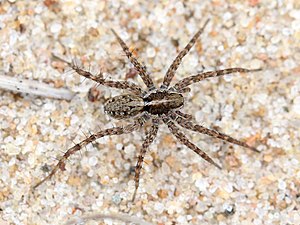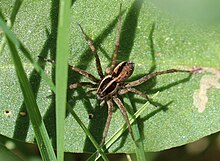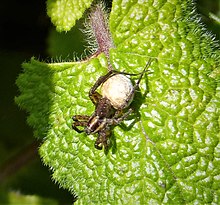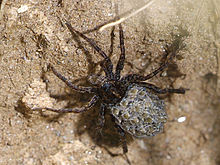Lean grass barrel grinder
| Lean grass barrel grinder | ||||||||||||
|---|---|---|---|---|---|---|---|---|---|---|---|---|

Lean grass barrel wolf ( Pardosa monticola ), female |
||||||||||||
| Systematics | ||||||||||||
|
||||||||||||
| Scientific name | ||||||||||||
| Pardosa monticola | ||||||||||||
| ( Clerck , 1757) |
The low grass barrel wolf ( Pardosa monticola ), also called low grass or mountain wolf spider , is a spider from the family of wolf spiders (Lycosidae). The Palearctic species is one of the common members of this family.
features
The female of the lean grass barrel wolf reaches a body length of five to seven and the male one of four to five millimeters. Like all run wolves ( Pardosa ), the lean grass barrel wolf is one of the smaller wolf spiders .
The prosoma (front body) is dark brown and has three light vertical stripes. One runs dorsally and narrows backwards. The other two run laterally on the edge of the prosoma and are not infrequently divided into two more by another dark longitudinal strip. The prosoma has a length of 2.3 to 2.7 millimeters.
The legs have a light brown basic color. They are spotted and curled on the dorsal side. This is especially true of the tibia (leg braces ) and metararsis ( phalanx ) of the third and fourth pair of legs.
The opisthosoma (abdomen) is brown in color and provided with a reddish and arrow-shaped line. Further back the opisthosoma shows yellow-red spots and black spots.
Structure of the sexual organs
The paired bulbi (male sexual organs) each have a small and a narrow terminal apophysis ( chitinized process).
The epigyne (female genital organ) is provided with more or less parallel septal margins, which can also be somewhat broadened towards the rear. The septum is longer than it is wide.
Similar species


There are three other types of barrel wolves ( Pardosa ), which look very similar to the grass-fed barrel wolf and with which it forms a species group.
One type of it is the field wolf ( P. agrestris ). In which the central and bright median band is not broadened towards the front. There are also some similarities with the variable common wolf ( P. agricola ), which also belongs to the species group . The posterior lateral eyes appear dorsally almost at the edge of the prosoma. In addition, the legs of the variable barrel wolf are colored yellow and clearly curled.
Most of the visual similarities exist with the meadow wolf ( P. palustris ), from which the lean grass wolf can be reliably distinguished by genital morphological features. In addition, the legs of the meadow wolf also appear yellower and the femora (thighs) dorsally markedly darkly spotted.
Occurrence

The low grass barrel grinder is represented in Europe , Turkey and Georgia . It is particularly found in Western and Central Europe, including the British Isles , but is preferred in the north and center of Scotland .
Habitats

According to its common name , the lean grass barrel wolf lives in dry areas, especially those on rocky or stony slopes. However, the species has also been found in damp habitats. The grassland running grinder can be found up to a height of about 2000 meters. Limestone-containing lawns and solid dunes are particularly preferred . The grassland running wolf has also been detected in other grasslands such as meadows and heaths . The species can be found most frequently in the biotopes of this species, which have been little influenced by human hands.
In Wiltshire, for example, the grassland running wolf has been found almost exclusively on short lawns or chalk areas.
Threat and protection
The lean grass barrel grinder can often be found in certain areas. It is classified in the Red List of Endangered Species of Animals, Plants and Fungi in Germany as "not endangered " and accordingly enjoys no protection.
The global population of the species is not recorded by the IUCN .
Way of life
Like all wild wolves, the low-grass barrel wolf is diurnal and, unlike other wolf spiders, does not create self-dug living tubes. The species lives freely on the ground.
Hunting behavior and catch of prey
Like almost all spiders, the grassland running wolf lives predatory and, like most of the wolf spiders, hunts prey freely and accordingly without a safety net . Like the other species in the family with this type of hunting, the spider perceives prey with the help of its well-developed sense of sight and overwhelms them after a jump and an immediately following bite, in which the spider venom is administered and the respective prey is thus incapacitated.
Life cycle
As with many spider species that are widespread in the temperate climate zones, the life cycle of the grass-fed running wolf depends on the seasons and extends over several phases.
Phenology
The activity time of the grass-fed running wolf runs over a large part of the year and for the females extends to the period between February and October. In the male, the range of activity from March to September is only slightly shorter. Adult specimens of the species are definitely active from early to mid-summer, and the females often even later.
Reproduction

The reproductive behavior of the grass-fed running wolf corresponds to that of other wolf spiders and so here, too, the male performs a species-specific courtship dance against a female . This includes trembling movements of the opisthosoma and an alternating lifting and lifting of the pedipalps (transformed extremities in the head area). Mating occurs when the female is willing to do so.
Some time afterwards, the female makes an egg cocoon , which, like all wolf spiders , is transported by it attached to the spinnerets . After hatching, the young spiders climb onto the mother's opisthosoma (this is another peculiarity of all wolf spiders) and let them carry them for a while before they separate from it. The young spiders overwinter and reach sexual maturity in the following year.
Systematics
When it was first described in 1757 by Carl Alexander Clerck, the grassland running wolf, like all spiders back then, was incorporated into the genus Araneus (today the genus of the non-closely related garden spiders ) and given the name Araneus monticola . The current name Pardosa monticola , with which the spider was classified in the genus Pardosa , was first used by Eugène Simon in 1876 and was used throughout with a few deviations.
The species name monticola comes from the Latin language and means "mountain-dwelling", although the grassland running wolf can also be found in non-mountainous habitats .
The grassland running wolf also has four subspecies:
- P. m. ambigua Simon , 1937
- P. m. minima Simon , 1876
- P. m. monticola Clerck , 1757
- P. m. pseudosaltuaria Simon , 1937
Individual evidence
- ↑ a b c d e f g h i Pardosa monticola (Clerck, 1757) from araneae - Spiders of Europe, accessed on June 15, 2020.
- ↑ a b c Heiko Bellmann: The cosmos spider guide. Over 400 species in Europe. Kosmos Naturführer, Kosmos (Franckh-Kosmos), 2nd edition, 2016, p. 166, ISBN 978-3-440-14895-2 .
- ↑ a b The Pardosa monticola species group at the Wiki of the Arachnological Society. V., accessed on June 15, 2020.
- ↑ Pardosa palustris (Linnaeus, 1758) from Natur in NRW, accessed on June 15, 2020.
- ^ Pardosa monticola (Clerck, 1757) at the Wiki der Arachnologische Gesellschaft e. V., accessed on June 15, 2020.
- ↑ a b Alopecosa inquilina (Clerck, 1757) in the WSC World Spider Catalog , accessed on June 15, 2020.
- ↑ a b c d Pardosa monticola (Clerck, 1757) at the British Arachnological Society, accessed June 15, 2020.
- ↑ Alopecosa inquilina (Clerck, 1757) at the Red List Center, accessed on June 15, 2020.
- ↑ a b Pardosa monticola (Clerck, 1757) at Global Biodiversity Information Facility , accessed on June 15, 2020.
- ^ Pardosa (CL Koch, 1847) at the Wiki der Arachnologische Gesellschaft e. V., accessed on June 15, 2020.
- ↑ A. Chiarle, T. Kronestedt, M. Isaia: Courtship behavior in European species of the genus Pardosa (Araneae, Lycosidae) , Journal of Arachnology 41, the second volume, 2013, pp 108-125, accessed on June 15 2020.
literature
- Heiko Bellmann: The cosmos spider guide. Over 400 species in Europe. Kosmos Naturführer, Kosmos (Franckh-Kosmos), 2nd edition, 2016, ISBN 978-3-440-14895-2 .
- A. Chiarle, T. Kronestedt, M. Isaia: Courtship behavior in European species of the genus Pardosa (Araneae, Lycosidae) , Journal of Arachnology 41, 2nd volume, 2013, pp. 108-125.
Web links
- Pardosa monticola in the World Spider Catalog
- Pardosa monticola (Clerck, 1757) at araneae - Spiders of Europe
- Pardosa monticola (Clerck, 1757) at Global Biodiversity Information Facility
- Pardosa monticola (Clerck, 1757) at Fauna Europaea
- Pardosa monticola (Clerck, 1757) at the Red List Center
- Pardosa monticola (Clerck, 1757) at the Wiki of the Arachnological Society e. V.
- Pardosa monticola (Clerck, 1757) at the British Arachnological Society

